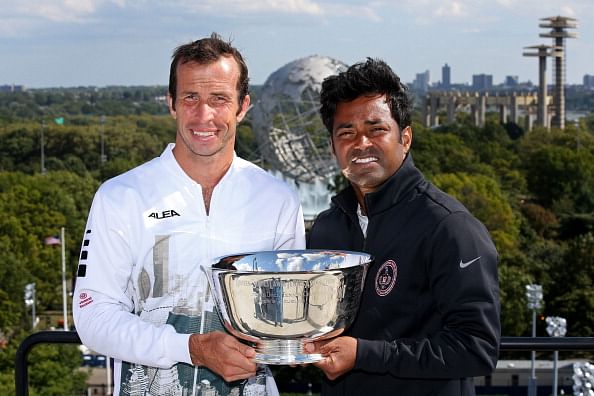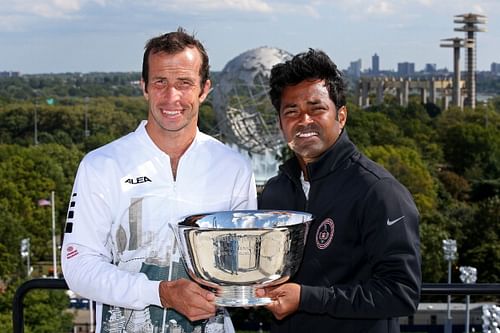
Older players continue to dominate Grand Slam tennis
Sport in general demands huge sacrifices – both personal and professional. Tennis is no different and perhaps being an individual sport, it places even more pressure on the players. After all, the rewards on doing well are to a large extent attributed to the individual and by that same logic, the consequences of bad performances are mostly borne by the said person.

Leander Paes (R) of India and Radek Stepanek (L) of the Czech Republic pose with their trophy with the of the Unisphere in the background after winning their men’s doubles final of the 2013 US Open at the USTA Billie Jean King National Tennis Center on September 8, 2013. (Photo by Matthew Stockman/Getty Images)
Thus, a player who is able to strike the right balance between being physically fit and mentally agile is the one on whom you can bet to have a long and hopefully, successful career. Of course it helps if you remain free from major injuries. Who knows what Richard Gasquet could have achieved had he avoided all those injuries and been surer of himself? He was often referred to as being another Roger Federer in the making (I reckon the one handed backhand had something to do with that).
This year’s US Open has once again highlighted that tennis has entered an era where it is almost impossible for a youngster to break through. Yes, there are those occasional upsets, but what is missing is the consistency. The older players are not just physically stronger but also mentally impenetrable. Can you imagine a 17 year old unseeded player winning a Grand Slam today? Boris Becker did that way back in 1984 when he won the Wimbledon.
Even the likes of Sloane Stephens, Eugenie Bouchard and Laura Robson seem to display a tenacity to beat top players for a mere one or two sets and fall at the next big hurdle. After defeating Serena Williams at the 2013 Australian Open, many people thought Sloane Stephens would become a top contender on the WTA. The reality though is far from that; she lost in the opening round at three WTA tournaments following her performance at Melbourne, and has since had an up and down year.
Given how physical the sport of tennis has become, one would logically assume that it’s the fresher legs who would have an advantage over those who have subjected their bodies to the wear and tear of gruelling ATP/WTA tours. But, the story playing out on the courts begs to differ.
I had almost forgotten how old Leander Paes, was until the statistics screen on the telly politely reminded me of my forgetfulness. He is 40 – and competing at the highest level. Agreed, he plays doubles which is not as taxing on your body as playing on the singles circuit. Nevertheless, playing a sport at the professional level puts huge demands on the body and mind of an athlete.
From winning an Olympic bronze in 1996 to winning his 14th Grand Slam in 2013, the journey for Paes has been longer than 17 years and has defied every conventional belief regarding tennis and age. A similar case can be made for the German comeback hero – Tommy Haas. At the age of 35, he is witnessing one of the most successful phases of his career and is on the verge of breaking into the top 10.
Things get even more interesting on the women’s side. If one were to consider the Grand Slam champions from 2008 to date, the average age of the winners is on the higher side of 20. Serena Williams on her own seems to have contributed generously to this statistic, winning four Grand Slams after she turned 30. Not to forget Francesca Schiavone who won the French Open in 2011 at the brink of turning 30 and Li Na who took over the title from her at the age of 28.
The legend of Kim Clijsters, who returned from motherhood to win three Grand Slams, all in her late 20s also tells a tale of its own. Victoria Azarenka summed it up efficiently when she joined five women above the age of 30 in the quarterfinals at this year’s US Open.
“Everybody’s taking much more care of their bodies to be able to play longer. So much more fitness has been introduced, nutrition, all those components that women and men are paying so much more attention to. It’s a great thing if we have longer careers.”